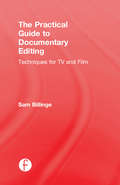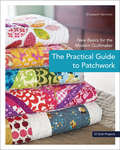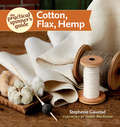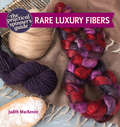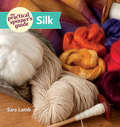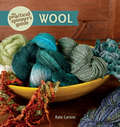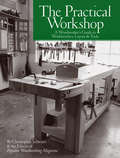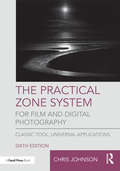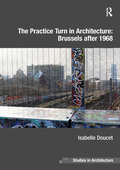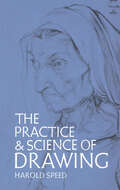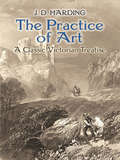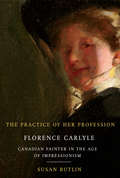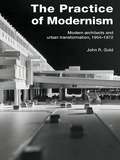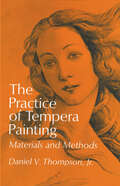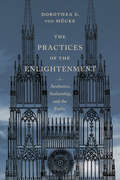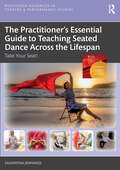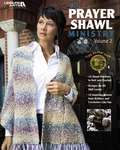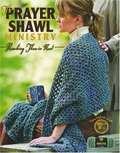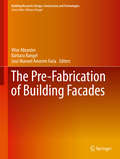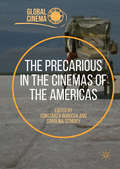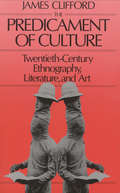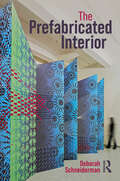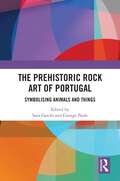- Table View
- List View
The Practical Guide to Documentary Editing: Techniques for TV and Film
by Sam BillingeThe Practical Guide to Documentary Editing sets out the techniques, the systems and the craft required to edit compelling professional documentary television and film. Working stage by stage through the postproduction process, author Sam Billinge explores project organization, assembling rushes, sequence editing, story structure, music and sound design, and the defining relationship between editor and director. Written by a working documentary editor with over a decade’s worth of experience cutting films for major British and international broadcasters, The Practical Guide to Documentary Editing offers a unique introduction to the craft of documentary editing, and provides working and aspiring editors with the tools to master their craft in the innovative and fast-paced world of contemporary nonfiction television and film.
The Practical Guide to Patchwork: New Basics for the Modern Quiltmaker
by Elizabeth HartmanQuilting basics with modern flair—with twelve projects for beginners, confident beginners, and intermediates. Winner of the Next Generation Indie Book AwardTry a fresh, relaxed approach to making quilts with this new book. The bright aesthetic and clear, simple instructions guide beginners and intermediates alike through the entire process of creating fun and useful quilts that they’ll be proud to call their own. Explore different options for each project in this book—make it with just two colors or scrappy, make it vintage or mod, make it soft or playful. Alternate colorways included with each project show you how swapping out fabrics can change the look of the same block. Learn how to cut, piece, appliqué, machine quilt, bind, and finish. Pick up helpful tips and tricks to stay organized and master the methods.
The Practical Spinner's Guide - Cotton, Flax, Hemp: Cotton, Flax, Hemp
by Stephenie GaustadA one-stop guide to preparing and spinning cotton, flax, and hemp! Over the last few years, focusing on specific types of fiber or spinning techniques has become more and more popular. In The Practical Spinner's Guide: Cotton, Flax, Hemp, author Stephenie Gaustad offers a detailed overview of each plant, the fiber it produces, and how to properly prepare, spin, and finish yarns made from each fiber. Cotton, flax, and hemp behave very differently from wool, and special handling is required. Stephenie discusses how each fiber behaves and how best to work with them, specifically touching on trouble spots such as drafting and adding twist. She also covers finishing yarns-cleaning, setting twist, and plying--as well as what dye processes are best for adding color. Finally, she includes a discussion of spinning for both knitting and weaving, covering fabric properties of each fiber, and what spinners need to take into account when using the yarn in a subsequent project.
The Practical Spinner's Guide - Rare Luxury Fibers
by Judith MackenzieIt's time to look beyond wool, with The Practical Spinner's Guide: Rare Luxury Fibers!The go-to expert for fiber artists, Judith MacKenzie shares insights into working with uncommon (but readily available) luxury downs in this comprehensive, yet practical, guide for today's spinners. With her natural voice for story telling that is both engaging and informative, she discusses the history of each of these downs, how they are used today, characteristics unique to each, and where to find them. She also dives deep into the specific spinning techniques for each fiber, knitting and weaving rare fibers, and dying them once spun.From angora to bison, camel to cashmere, there's a whole world of rare luxury fibers just waiting to be spun!
The Practical Spinner's Guide - Silk
by Sara LambExplore silk--an alluring and exotic fiber for spinners! The Practical Spinner's Guide: Silk teaches spinners how to create smooth lustrous yarns from a gorgeous but tricky and sometimes intimidating fiber in this second installment in a series of fiber specific books. Author Sara Lamb discusses the various forms in which silk is available--combed top, bricks, noils, hankies, and bells--and how best to card, prep, and spin them, specifically touching on trouble spots such as drafting and adding twist. She also covers finishing yarns--cleaning and degumming, setting twist, and plying--and even touches on what dye processes are best for adding color, as well as how to blend silk into other spinning fibers. Sara includes brief discussions on spinning for both knitting and weaving, the properties of woven and knitted fabric, and what the spinner needs to take into account while creating yarn for a subsequent project.
The Practical Spinner's Guide - Wool
by Kate LarsonAll you need to know about spinning wool--from sheep to knits!Spinners have been creating beautiful yarns from wool for thousands of years, but we still have unanswered questions. How do you choose a fleece? Should you process your fleece by hand or send it to a mill? What kind of prepared fibers are available, and what should you do with them? Fiber artist and shepherdess Kate Larson answers these and many other questions in The Practical Spinner's Guide: Wool. Topics include:An overview of sheep breeds and the characteristics of their fleeceWashing, carding, combing, and blending fibersPurchasing and working with prepared fibersTechniques for spinning and plying wool to achieve the right yarn for your projectsAdvice on caring for fibers to protect them from unwanted pests and other problemsWhether you're working with fleeces sheared from your own flock or spinning indie dyed fibers, you'll find a wealth of useful, valuable, and practical information in The Practical Spinner's Guide: Wool.
The Practical Workshop: A Woodworker's Guide to Workbenches, Layout & Tools
by Christopher Schwarz Popular Woodworking EditorsEverything in its place.... Whether woodworking is your hobby or your profession, you'll get more enjoyment and satisfaction from the craft when you have a practical and functional workspace.The Practical Workshop is your guide to setting up a sensible shop with an efficient workflow and everything you need to make the best use of your time. From workbenches to shop furniture to storage solutions, this book covers the essentials. You'll learn strategies for machine and fixture placement. You'll discover ways to streamline your operations and get plans for all the shop furniture you need to outfit your space.Get started with guidelines for putting together a basic toolkit and some quick sawhorses.Focus your shop around a central workbench--you'll find complete plans for two benches, a gallery of bench designs and ideas for personalizing your workbench for your specific needs.Get helpful advice for placing machinery and instructions for building shop furniture and fixtures.Woodworking can be a respite from the bustle of daily life, especially if your shop is well-organized and your tools are where they're supposed to be. This book can help you set up a great workspace, avoid clutter and get the most out of your woodworking.
The Practical Zone System for Film and Digital Photography: Classic Tool, Universal Applications
by Chris JohnsonThis sixth edition of The Practical Zone System by Chris Johnson updates the classic manual on Ansel Adams's landmark technique for the digital age. For photographers working digitally or with film, in color or black and white, in the studio or on the go, this simple visual language helps to control contrast and, through a process called Previsualization, provides photographers with the power of free creative expression. This new edition discusses recent advances in technology and potentials for their use in zone photography, including HDR, smartphone cameras that shoot in raw format and smartphone light meters. Johnson demonstrates how the Zone System is a universal visual and conceptual language that dramatically simplifies the problem of creating and rendering complex lighting setups.
The Practice Turn in Architecture: Brussels After 1968 (Ashgate Studies in Architecture)
by Isabelle DoucetWhat makes a city? What makes architecture? And, what is to be included in the discussions of architecture and the city? Attempting to answer such ambitious questions, this book starts from a city’s specificity and complexity. In response to recent debates in architectural theory around the agency and locus of critical action, this book tests the potential of criticality through-practice. Rather than through conceptual and ideological categorisations, it studies how architecture and criticality work within specific circumstances. Brussels, a complex city with a turbulent architectural and urban past, forms a compelling case for examining the tensions between urban politics, architectural imaginations, society’s needs and desires, and the city’s history and fabric. Inspired by pragmatist-relational philosophies, this book tests the potential of criticality through-practice. It studies a series of critical actions and tools, which occurred in Brussels’ architectural and urban culture after 1968. Weaved together, Brussels architectural production emerges from a variety of actors, including architects, urban policy makers, activists, social workers, and citizens, but also architectural movements and ideologies, urban renewal programs, urban traumas, plans and projects, and mundane everyday practices and constructions. This book contributes to the study of Brussels and offers a timely contribution to recent scholarship on the critical reappraisal of architectural debates from the 1960s through to the 1990s. In addition, by showing how pragmatist-relational philosophies can be made relevant for architectural theory, the book opens hopeful potentials for how architectural theory can better contribute to the formulation of a critical agenda for architecture.
The Practice and Science of Drawing: With 93 Illustrations And Diagrams... - Primary Source Edition (Dover Art Instruction)
by Harold SpeedMuch of the learning to practice as well as to appreciate art is concerned with understanding the basic principles. One of these principles is what Harold Speed calls "dither," the freedom that allows realism and the artistic vision to play against each other. Very important to any artist or work of art, this quality separates the scientifically accurate from the artistically accurate. Speed's approach to this problem is now considered a classic, one of the few books from the early years of this century that has continued to be read and recommended by those in the graphic arts.In this work, Harold Speed approaches this dynamic aspect of drawing and painting from many different points of view. He plays the historical against the scientific, theory against precise artistic definition. He begins with a study of line drawing and mass drawing, the two basic approaches the artist needs to learn. Further sections carry the artistic vision through unity and variety of line and mass, balance, proportion, portrait drawing, the visual memory, materials, and procedures. Throughout, Speed combines historical backgrounds, dynamic aspects which each technique brings to a work of art, and specific exercises through which the young draughtsman may begin his training. Although not a technique book in the strict sense of the terms, The Practice and Science of Drawing brings to the beginner a clear statement of the principles that he will have to develop and their importance in creating a work of art. Ninety-three plates and diagrams, masterfully selected, reinforce Speed's always clear presentation.Harold Speed, master of the art of drawing and brilliant teacher, has long been cited for this important work. For the beginner, Speed will develop a sense for the many different aspects which go into an artistic education. For the person who enjoys looking at drawings and paintings, Speed will aid developing the ability to see a work of art as the artist meant it to be seen.
The Practice of Art: A Classic Victorian Treatise
by J. D. HardingOriginally published in 1845 as The Principles & Practice of Art: With Illustrations Drawn and Engraved by the Author, this enduring guide is the work of an English painter and lithographer. J. D. Harding wrote several popular books on art instruction, and this volume constitutes one of his finest. A comprehensive manual geared toward practicing artists, the book features 24 black-and-white plates of illustrations by Harding that elucidate his observations and instructions. Topics include:• Imitation as Applied to Art • The Distinction Between the Judgment and the Feelings with Respect to Art• Beauty and Form • Composition • Light and Shade • Color• Drawing from Nature Art historians and students—especially those of nineteenth–century art—will prize this book for its philosophical theory of beauty and its abundant supply of illustrative examples, rendered in various styles of engraving and lithography.
The Practice of Her Profession
by Susan ButlinIn The Practice of Her Profession, Susan Butlin draws on unpublished letters and family memoirs to recount Carlyle's personal and professional life. She explores Carlyle's artistic influences, her relationships with artist colleagues and encounters with the cultural worlds of Paris, New York, and early twentieth-century Canada, and provides a detailed examination of Carlyle's paintings. Butlin's vivid description of the artistic life of women of this era, from access to art training to the important role of women's art societies, introduces readers to Carlyle's many accomplished contemporaries - Helen McNicoll, Mary Reid, Laura Muntz, Sarah Holden, Sydney Tully, Elizabeth McGillivray Knowles, and others.
The Practice of Her Profession: Florence Carlyle, Canadian Painter in the Age of Impressionism (McGill-Queen's/Beaverbrook Canadian Foundation Studies in Art History #1)
by Susan ButlinIn The Practice of Her Profession, Susan Butlin draws on unpublished letters and family memoirs to recount Carlyle's personal and professional life. She explores Carlyle's artistic influences, her relationships with artist colleagues and encounters with the cultural worlds of Paris, New York, and early twentieth-century Canada, and provides a detailed examination of Carlyle's paintings. Butlin's vivid description of the artistic life of women of this era, from access to art training to the important role of women's art societies, introduces readers to Carlyle's many accomplished contemporaries - Helen McNicoll, Mary Reid, Laura Muntz, Sarah Holden, Sydney Tully, Elizabeth McGillivray Knowles, and others.
The Practice of Modernism: Modern Architects and Urban Transformation, 1954–1972
by John R. GoldIn this sequel to his widely-acclaimed book The Experience of Modernism (1997), John Gold continues his detailed enquiry into the Modern Movement's involvement in urban planning and city design. Making extensive use of information gained from hours of in-depth interviews with architects of the time, this new book examines the complex relationship between vision and subsequent practice in the saga of postwar urban reconstruction. The Practice of Modernism: traces the personal, institutional and professional backgrounds of the architects involved in schemes for reconstruction and replanning deals directly with the progress of urban transformation, focusing on the contribution that modern architects and architectural principles made to town centre renewal and social housing highlights how the exuberance of the 1960s gave way to the profound reappraisal that emerged by the early 1970s. Written by an expert, this is a key book on the planning aspects of the modernist movement for architectural historians, urban geographers, planners and all concerned with understanding the recent history of the contemporary city.
The Practice of Public Art: Art, Space, And Social Inclusion (Routledge Research in Cultural and Media Studies #Vol. 14)
by Cameron Cartiere Shelly WillisThis exciting new collection of essays by practicing artists, curators, activists, art writers, administrators, city planners, and educators offers divergent perspectives on the numerous facets of the public art process. The volume also includes a useful graphic timeline of public art history.
The Practice of Tempera Painting: Materials and Methods (Dover Art Instruction)
by Daniel V. ThompsonTempera painting, the method in which colors are mixed with some binding material other than oil (primarily egg yolk), is the earliest type of painting known to man. The wall paintings of ancient Egypt and Babylon are tempera, as are many of the paintings of Giotto, Lippi, Botticelli, Raphael, Titian, Tintoretto, and many other masters. But in spite of the time-proven excellence of this technique -- which boasts many clear advantages over oil paint -- it does not receive the degree of attention from modern painters that it deserves.Part of the explanation for this neglect, surely, is the absence of sufficient information about the materials and procedures involved in tempera painting. The present volume, in fact, is virtually the only complete, authoritative, step-by-step treatment of the subject in the English language, D.V. Thompson wrote this book after an exhaustive study, over many years, of countless medieval and Renaissance manuscripts in the British Museum and elsewhere, and is unquestionably the world's leading authority on tempera materials and processes.Beginning with an introductory chapter on the uses and limitations of tempera, the author covers such topics as the choice of material for the panel; propensities of various woods; preparing the panel for gilding; making the gesso mixture; methods of applying the gesso; planning the design of a tempera painting; use of tinted papers; application of metals to the panel; tools for gliding; handling and laying gold; combination gold and silver leafing; pigments and brushes; choice of palette; mixing the tempera; tempering and handling the colors; techniques of the actual painting; mordant gilding; permanence of tempera painting; varnishing; and artificial emulsion painting. The drawings and diagrams, illustrating the various materials and techniques, infinitely increase the clarity of the discussions. As a careful exposition of all aspects of authentic tempera painting, including many of the possible modern uses for this ancient method, this book actually stands alone. No one who is interested in tempera painting as a serious pursuit can afford to be without it.
The Practices of the Enlightenment: Aesthetics, Authorship, and the Public (Columbia Themes in Philosophy, Social Criticism, and the Arts)
by Dorothea Von MückeRethinking the relationship between eighteenth-century Pietist traditions and Enlightenment thought and practice, The Practices of Enlightenment unravels the complex and often neglected religious origins of modern secular discourse. Mapping surprising routes of exchange between the religious and aesthetic writings of the period and recentering concerns of authorship and audience, this book revitalizes scholarship on the Enlightenment.By engaging with three critical categories—aesthetics, authorship, and the public sphere—The Practices of Enlightenment illuminates the relationship between religious and aesthetic modes of reflective contemplation, autobiography and the hermeneutics of the self, and the discursive creation of the public sphere. Focusing largely on German intellectual life, this critical engagement also extends to France through Rousseau and to England through Shaftesbury. Rereading canonical works and lesser-known texts by Goethe, Lessing, and Herder, the book challenges common narratives recounting the rise of empiricist philosophy, the idea of the "sensible" individual, and the notion of the modern author as celebrity, bringing new perspective to the Enlightenment concepts of instinct, drive, genius, and the public sphere.
The Practitioner’s Essential Guide to Teaching Seated Dance Across the Lifespan: Take Your Seat! (Routledge Advances in Theatre & Performance Studies)
by Samantha JenningsThis book is a seminal seated dance guidebook for global dance and health practitioners. Seated dance is an inclusive and diverse form of physical activity, suitable for all, regardless of age or disability.The book offers valid advice, inspiration and a wide range of tried and tested teaching and learning approaches to help practitioners succeed in the seated dance classroom, covering all ages and settings. This book introduces a potted historical journey of seated dance and subsequently guides the professional practitioner through the critical stages of setting up professional, safe and creative seated dance sessions. Research and evidence are gathered ‘in and on practice’ through the author’s dedicated dance career and teaching reflections as a Royal Academician of Dance (RAD) teacher and are underpinned by a theoretical background in mental health and wellbeing in education. It contains contributions by valued peers and professionals and extracts from research theorists in the field. ‘Take Your Seat’ is a career professional development Group-approved text (CPD) enabling the reader to claim personal and professional development points. The author places the art of seated dance at the centre of dance education, making it inclusive, diverse, accessible and justifiable in today's various dance arts and health settings.This book integrates the author's extensive experience in dance, contemporary mental health and wellbeing research and insights from esteemed peers. It empowers practitioners to embrace diverse perspectives, fostering an inclusive and forward-thinking dance environment.
The Prayer Shawl Ministry, Volume 2
by Lion Brand YarnThis eagerly anticipated second volume of The Prayer Shawl Ministry book includes 10 shawl patterns to knit or crochet and a heartwarming follow-up on the ministries introduced in the first book. Readers will identify with the dozens of letters to The Lion Brand Yarn Company from individuals sharing what the ministry means to them. This photo-rich book also includes prayers for many occasions and concerns, a handy guide to Lion Brand Homespun colors, and a brief overview of the new volunteer movement on friendship shawls, an idea promoted by the Warm Up America! Foundation.
The Prayer Shawl Ministry: Reaching Those in Need
by Leisure ArtsMake a prayer shawl, and make a difference. Join the thousands of knitters and crocheters of all faiths who are creating handmade shawls for those in need. Whatever your faith and wherever you live, your handiwork will be a gift of comfort, hope, and peace.
The Pre-Fabrication of Building Facades
by Vítor Abrantes Bárbara Rangel José Manuel Amorim FariaThis book compares two buildings with different technologies and distinct environment from the combined viewpoints of civil engineering and architecture. The first is the most recent building of Columbia University in New York, the Northwest Science Building, a project designed by Rafael Moneo and Dan Brodkin of Ove Arup. The second one is the Burgo Tower in Oporto, by Eduardo Souto Moura and Rui Furtado of AFA, a building that brings a new perspective to the use of prefabrication technologies with local traditional construction systems. With the detailed analyses of recognized researchers in civil engineering and architecture, this book is a reflection upon the problems and solutions in the design and construction process of a prefabricated building system. This volume, like those to follow, brings together, building research and building design practice to enhance the knowledge of complementarity areas involved in construction, engineering and architecture. This is the first book in a new series "Building Research: Design, Construction and Technologies" which aims to bridge scientific research and professional practice to understand the Building Design problems. In each edition, one or two case studies (recognized buildings in the international design panorama) are analyzed with their authors to assess the design process and the construction development. To understand the problems involved, researchers, engineers and architects, are asked to contribute to this ana lysis with essays on building research issues, as building technology, construction management, acoustics, maintenance or prefabrication.
The Precarious in the Cinemas of the Americas (Global Cinema)
by Constanza Burucúa Carolina SitniskyHistorically, cinema in the Americas has been signed by a state of precariousness. Notwithstanding the growing accessibility to video and digital technologies, access to the material means of film production is still limited, affecting the spheres of production, distribution, and reception. Equally, questions about the precarious can be traced in cultural and archival policies, film legislations, as well as in thematic and aesthetic choices. While conventional definitions of the precarious have been associated with notions of scarcity and insecurity, this volume looks at precariousness from a non-monolithic angle, exploring its productivity and potential for original, critical approaches, with the aim of providing new readings to the variedly rich and complex cinemas of the Americas.
The Predicament of Culture
by James CliffordThe Predicament of Culture is a critical ethnography of the West in its changing relations with other societies. Analyzing cultural practices such as anthropology, travel writing, collecting, and museum displays of tribal art, Clifford shows authoritative accounts of other ways of life to be contingent fictions, now actively contested in postcolonial contexts. His critique raises questions of global significance: Who has the authority to speak for any group's identity and authenticity? What are the essential elements and boundaries of a culture? How do self and "the other" clash in the encounters of ethnography, travel, and modern interethnic relations? In discussions of ethnography, surrealism, museums, and emergent tribal arts, Clifford probes the late-twentieth century predicament of living simultaneously within, between, and after culture.
The Prefabricated Interior
by Deborah SchneidermanThough much attention has been given to the prefabrication of architecture, there has been little discussion on the influence and importance of prefabrication within the interior environment.This book does just that, providing a comprehensive investigation into the prefab interior from the 19th century to the present and beyond. Each chapter focuses on a typology of the prefabricated interior, looking at the bathroom, kitchen, workspace, furniture, mobile interiors, the prefab house, textiles, wearables, and the digital realm of printed interiors. Taken as a group, these chapters and illustrations indicate that constructs of the interior have been pivotal in the generation of techniques and processes of prefabrication in architecture and the built environment. Chapters explore a diverse range of examples of innovative prefabricated elements and assemblages within interior environments, illustrating the inherent sustainability, accessibility, building efficiency, and affordability of prefabricated design.The culmination of a decade of research by the leading expert on the topic, this will be the go-to resource on prefabricated interiors and an important read for all students and researchers in interior design.
The Prehistoric Rock Art of Portugal: Symbolising Animals and Things
by George Nash Sara GarcêsThe Prehistoric Rock Art of Portugal presents significant interpretive perspectives in Portuguese rock art research and offers an excellent representation of core rock art areas, along with current thinking and interpretations. The various chapters deliver a personal approach to the many issues, themes and approaches that are embedded within the rock art of the outpost of western Atlantic Europe. Ethnographical perspectives have often dominated the study of rock art but unlike other well-studied regions, the western Iberian Peninsula is absent of an ethnographical or ethno-historical past and therefore the production of rock art can only be archaeologically assessed. Thus, the work promotes interpretive perspectives on Portuguese rock art, illustrating the richness, chronology and context of these unique artistic expressions and explores the variability of rock art imagery and the diversity of landscapes and social contexts in which it was produced. Although focusing on Portuguese rock art the book includes a number of universal themes that will appeal to a broad range of scholars researching in archaeology and anthropology, history of art, as well as professionals engaged in rock art heritage and conservation.
